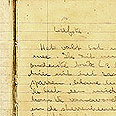
A Rare Dutch Diary Revealed After 60 Years
Anne Frank wasn’t alone. A notebook depicts the last days of an 18-year-old girl in an S.S. camp
AMSTERDAM – Helga Deen was in the middle of her final school year when she and her family were deported to the Vaught concentration camp located in the southern part of the Netherlands.
On her arrival at the camp on April 1, 1943, she began writing a diary aimed at documenting her experiences for her Dutch boyfriend, Kees van den Berg, who had remained free.
Helga was only permitted to write letters on the camp’s official stationery, which was then censored. As she refused to share her innermost feelings with the camp wardens Helga decided to write her entries into her school notebook.
The “diary” and five other letters were eventually smuggled out of the camp and reached their destination. Kees sent his replies to the Westerbork transit camp, which was where Helga had written that the family had been transferred. But the letters returned with the stamp “return to sender.”
The Deen family hadn’t spent much time at the Westerbork transit camp. Immediately on arrival they had been deported to the Sobibor camp in Poland where Helga, her parents and her 15-year-old brother met their deaths on July 16th, 1943.
Sixty years later, Kees’ son, Conrad van den Brach, contacted the city archive and asked them whether they would like to take a look at the treasure he had received from his father. Along with the diary, Kees also sent a fountain pen and a lock of hair inside an old brown handbag.
On receiving the historic document, archive employee Grit Kobes was beside himself.
“My hair stood on end when I saw the diary,” he said. “It is a unique document.”
The entries were written onto a school notebook, which included 21 pages and several penciled drawings of the camp.
“The entries had been written over the course of a single month. Helga didn’t add an entry everyday; there are days with just a few sentences and others that fill one or two pages,” Kobes said.
The entries recount the impressions of a young girl, without mentioning historical events.
According to Kobes, who read the entire diary, the entries portray a sharp, sensitive woman with an invincible will. He said the diary apparently helped ease her despair, her helplessness, and her desire to resume a normal life.
The diary entries describe Helga’s physical and emotional state. She was angered at being turned into a second-class citizen in her own country. She found it difficult to be separated from her boyfriend and friends despite being allowed to walk around the camp, read, write and talk to her family.
“Every entry begins with ‘My beloved’ and ends with ‘until we meet again,’ alluding to her yearning that the terrible ordeal would eventually come to an end,” Kobes said.
She wrote: “My beloved, so far, it’s not as bad as I thought it would be. I’m sitting in an empty hut on the lower bunk bed, and if I look through the window I can see the pine trees, the blue sky and the pale clouds.”
Kees said he believes that this entry portrays Helga’s optimism.
“Perhaps she preferred keeping the truth from her boyfriend,” he said.
Two days later the tone of the entry takes a turn for the worse when she describes the delousing procedure at the camp.
On July 2 Helga was summoned to the Phillips factory for a job, which may have saved her life. But the summons came too late. On that same day she was deported to Westerbork transit camp.
Some 1,270 children aged between 0-16 were transferred to Westerbork accompanied by a single parent. Within days they were deported to the Sobibor extermination camp in Poland to join the list of Nazi victims.
In her last entries the drama had become too intense for Helga to describe. Her broken sentences are testimony to the anguish she endured:
“Transfer, that’s too much. I can’t take any more. But I want, I want my happiness,” (the rest of the sentence is illegible). “If my willpower dies, I too will die. This is so I never forget.” Helga wrote.
Holocaust researcher Elsa Van der Mir, documenting the Vught concentration camp, said the diary is an amazing find. She said the only diary in her possession until now was written by an intern called David Cocker, which was published in 1977.
Parts of the Helga Deen diary were put on display in Tilburg, and the archive is negotiating with museums to show it elsewhere.











